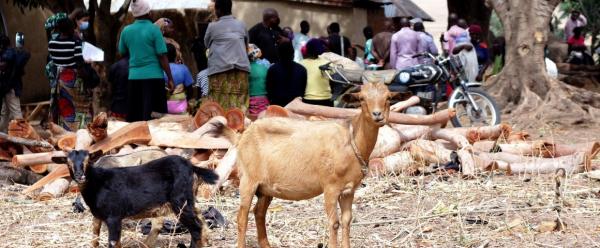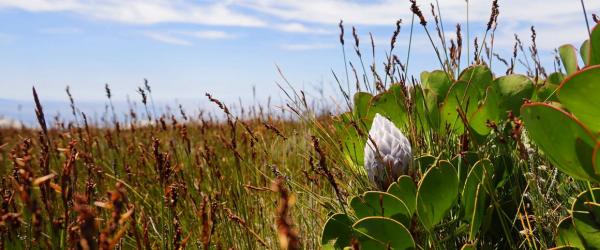Results & impact 28 October 2025
- Home
- CIRAD news
- News
- RELAX - Dietary diversity and malnutrition
Boosting dietary diversity to address chronic malnutrition
.jpg)
In the cotton-growing regions of Burkina Faso, meals are based on a very limited number of foods: maize tô, groundnuts, okra, and a few leafy vegetables © A. Lourme-Ruiz, CIRAD
Some parts of West Africa have considerably increased their agricultural production in recent decades. However, food and nutrition security for the people living there is still far from assured. In these landscapes dominated by fields of cotton and maize, “meals are based on a very limited number of foods: maize tô, groundnuts, okra, and a few leafy vegetables”, says Alissia Lourme-Ruiz, an economist at CIRAD involved in the RELAX project.
The different recipes for sauces to accompany tô show good potential for diversity, but in practice they are often too simple. Many perishable foods, such as mangoes, are seasonal, and gathered produce, such as fruits, are now much harder to find than in the past. Diversified foods are available on markets, but are unaffordable for most families.
Deficiencies with adverse health effects
Food diversity is very low throughout the year. This causes vitamin and mineral deficiencies that stunt growth in children, can cause irreversible physical and cognitive disorders and significantly increase mortality. These are major concerns, with the project revealing that 80% of the women surveyed are at risk of micronutrient deficiencies.
Between agricultural production, gathering and market purchases, how is food diversity shaped in rural households in Burkina Faso? A multidisciplinary scientific team has worked to answer this question in the context of the RELAX project, coordinated by CIRAD with several partners* and financed by the Agropolis, Daniel and Nina Carasso, and Cariplo foundations.
Based on their in-depth studies, the researchers have identified different drivers and produced a number of operational recommendations.
- Decompartmentalizing nutrition and agriculture
Policy decisions function in silos: on the one hand, agriculture takes little account of food and nutrition issues, and on the other, health fails to integrate agricultural realities. “People only tend to take an interest in their diet when they get sick”, says Charlotte Yaméogo, a socio-anthropologist of food at IRSAT (Burkina Faso).
- Raising awareness of the importance of dietary diversity
Within households, agricultural decisions are disconnected from food diversity considerations. The extreme monotony and simplification of meals is not perceived as a problem, either at the policy level or at the household level. Priority is systematically given to cereals.
- Encouraging variety in food production
Many foods that are important in a balanced diet (legumes, eggs, meat, dairy products) are produced insufficiently on farms and are mainly intended for sale and savings. According to Souleymane Ouedraogo, an agronomist at INERA (Burkina Faso), “households need to be encouraged to produce mung beans, papayas, orange-fleshed sweet potatoes, aubergines and small livestock. Even though a large proportion is sold to generate monetary income that is important for the household economy, a certain amount is often consumed and contributes to dietary diversification”.
- Promoting agroforestry crops
Fruits, leafy vegetables, nuts and seeds, insects, etc., the trees found in fields provide valuable biodiversity. “We have shown that the biodiversity in agroforestry plots contributes to improving food diversity for women, and therefore for households”, says Christophe Koffi, an ecologist at the University of Man (Ivory Coast).
- Developing preservation techniques
Fruit and vegetables are mainly consumed during the short harvesting season, because there are no means of preservation available. According to Alissia Lourme-Ruiz, “it is important to promote preservation methods such as fermentation or drying”, in order to improve food diversity throughout the year and in particular in the months when few foods are available.
- Developing school canteens
The scientists did not observe any individual inequalities during meals taken at home. However, family members who have the possibility to eat away from home often have better food diversity. This is the case of men who work outside their village and children who eat in school canteens. Developing school canteens can be a valuable tool to rapidly increase food diversity for children and to reduce childhood malnutrition.
The specialization of the production system in this region has resulted in undeniable progress in safeguarding cereal crops in recent decades. However, the reduction in the number of foods from agriculture, hunting and gathering has not been offset by market access, which remains difficult for most households. Reinventing a more nourishing agricultural system, combining a diversity of products for sale and for own consumption, while contributing to the preservation of local natural resources, are desirable pathways to improve the health of farming families and are compatible with the principles of agroecology.
In agricultural households, men are responsible for supplying cereals, and women for supplying the ingredients used in sauces. In this respect, women are central to food diversity issues. Their power and their access to resources matter: when their income, their time available for themselves and their children and their knowledge improve, food diversity also improves.
* CNRST, GRET, INERA, IRAM, IRD and IRSAT.
The RELAX project (N° AF 1507-329 ; N° FC 2015-2440, N° FDNC Engt 00063479) is financed as part of the “Thought for Food” project by Agropolis Fondation (Investissement d’Avenir programme, financing ANR-10-LABX-0001-01), Fondazione Cariplo and Fondation Daniel et Nina Carasso.



























